Circuit design of in-situ training memristive backpropagation neural network
IF 3.2
3区 计算机科学
Q2 ENGINEERING, ELECTRICAL & ELECTRONIC
Aeu-International Journal of Electronics and Communications
Pub Date : 2025-07-15
DOI:10.1016/j.aeue.2025.155919
引用次数: 0
Abstract
Memristive backpropagation (BP) neural network in-situ training is of significant importance for accelerating data processing. Currently, three main challenges hinder circuit design of the in-situ training memristive BP neural network: first, achieving circuit timing control without computer assistance is difficult; second, for the existing memristive BP neural network, it is hard to convert the change of weight values to memristance change; third, there is a lack of memristor control strategy suitable for in-situ training. To address the three challenges, this paper proposes a timing control method that does not require computer assistance, utilizing MOS transistors and analog value storage circuits to divide the training of the memristive BP neural network into four phases. Next, a novel memristor array is designed in which memristance correspond to the weight value linearly. Therefore, the weight change obtained by BP algorithm is convenient to be transferred as memristance change. Then, characteristics of the memristor are analyzed to map the memristance change as the corresponding control pulse. The amplitude of the control pulse are calculated by the multiplication and division circuit. Finally, XOR, iris classification, and MNIST digit classification experiments are conducted on the proposed memristive BP neural network circuit, proving that the proposed circuit design has good performance.
原位训练记忆反向传播神经网络电路设计
记忆反向传播(BP)神经网络的原位训练对于加速数据处理具有重要意义。目前,原位训练记忆性BP神经网络的电路设计面临三大挑战:一是在没有计算机辅助的情况下难以实现电路定时控制;其次,现有的忆阻BP神经网络难以将权值的变化转化为忆阻变化;三是缺乏适合现场训练的忆阻器控制策略。针对这三个挑战,本文提出了一种不需要计算机辅助的定时控制方法,利用MOS晶体管和模拟值存储电路将忆阻BP神经网络的训练分为四个阶段。其次,设计了一种新的忆阻器阵列,其中忆阻与权值线性对应。因此,BP算法得到的权值变化便于作为电阻变化进行传递。然后,分析了忆阻器的特性,将忆阻变化映射为相应的控制脉冲。控制脉冲的幅度由乘法和除法电路计算。最后,对所提出的记忆BP神经网络电路进行了异或、虹膜分类和MNIST数字分类实验,证明了所提出的电路设计具有良好的性能。
本文章由计算机程序翻译,如有差异,请以英文原文为准。
求助全文
约1分钟内获得全文
求助全文
来源期刊
CiteScore
6.90
自引率
18.80%
发文量
292
审稿时长
4.9 months
期刊介绍:
AEÜ is an international scientific journal which publishes both original works and invited tutorials. The journal''s scope covers all aspects of theory and design of circuits, systems and devices for electronics, signal processing, and communication, including:
signal and system theory, digital signal processing
network theory and circuit design
information theory, communication theory and techniques, modulation, source and channel coding
switching theory and techniques, communication protocols
optical communications
microwave theory and techniques, radar, sonar
antennas, wave propagation
AEÜ publishes full papers and letters with very short turn around time but a high standard review process. Review cycles are typically finished within twelve weeks by application of modern electronic communication facilities.

 求助内容:
求助内容: 应助结果提醒方式:
应助结果提醒方式:


